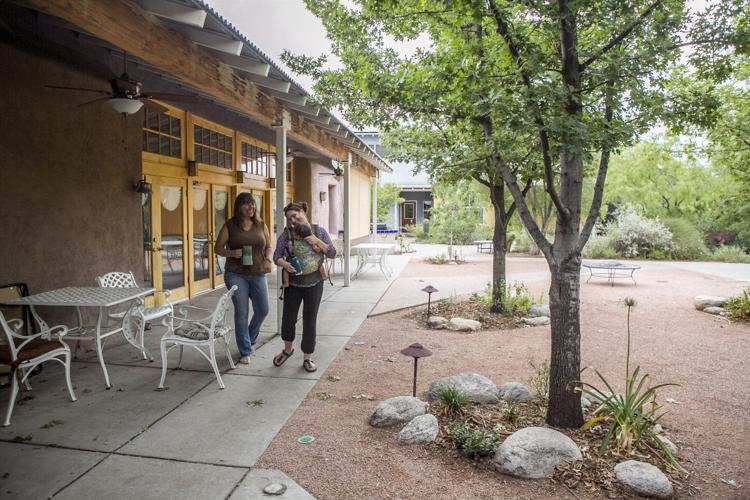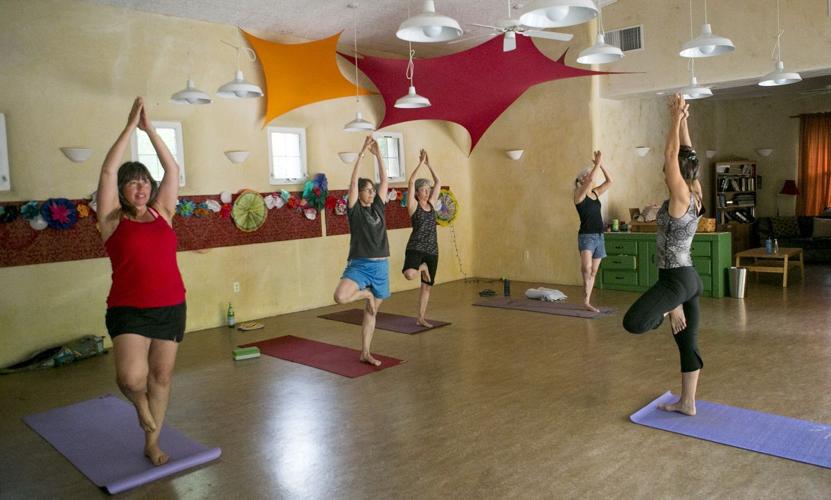Imagine living in a community where everyone knows your name, remembers your birthday and offers to make you dinner on a regular basis.
Three Tucson communities have embraced such a lifestyle, called “cohousing,” which is a growing housing trend nationwide.
Dubbed “intentional, collaborative neighborhoods that combine extensive common facilities with private homes,” cohousing appears to be the antithesis of today’s computer-connected world.
It involves contact and conversation.
“It’s a commitment to knowing each other,” said Martha Depauli, a resident of Sonora Cohousing near Roger Road and First Avenue. “The community members want to participate in each other’s lives.”
Sonora has 36 homes on 4.8 acres of land. Like most cohousing developments, the parking lots surround the community so residents walk through the common areas on their way to and from their cars.
Depauli, 53, has lived there since 2000.
Neighbor Mechelle Meixner, 49, moved in nine years ago. She said the difference between cohousing and living in an apartment with shared amenities is “intentionality.”
“That really matters,” she said. “People are living together like an extended family; we don’t just have a cool community pool.”
Since being introduced in the United States 25 years ago, more than 160 cohousing communities have been developed and 120 more are under construction, the Cohousing Association of the United States says.
“Cohousing communities are part of the new sharing economy and are predicted to expand rapidly in the next few decades as individuals and families seek to live more sustainably, and changing demographics force us to find innovative ways to address the roles traditionally played by extended families,” the association said.
Experts on housing and senior issues predict cohousing will become a way of caring for the senior population as residents look out for one another.
Tucson already has senior communities with a focus on socialization.
Las Abuelitas Family Housing, in South Tucson, was developed by the Primavera Foundation for seniors who are raising their grandchildren so they can consult with one another and arrange cooperative carpools or child care.
Sunnyside Pointe, near Park Avenue and Irvington Road, is a multifamily development by La Frontera Arizona and Old Pueblo Community Services. It is a senior community within a multifamily community, so young families can have their parents nearby.
But cohousing takes it a step further.
Many amenities are shared, such as laundry, office space, crafts rooms and meals.
A community kitchen features commercial-grade appliances where residents can whip up a meal and anyone can saunter in with a dinner plate.
Leftovers are placed in the refrigerator for anyone to snack on.
Kat Jimenez, 43, moved from Page to Stone Curves Cohousing Community near Stone Avenue and Limberlost Drive in 2013.
“I tried to make a community in Page because it’s a small town,” she said. “But it was really hard to get together, to coordinate play dates. I wondered, ‘Where is the sense of community?’”
Her husband and three children, 9, 10 and 12, now have that.
“You just walk out the door and there it is,” Jimenez said.
Stone Curves has 48 units on 5.1 acres of land with similar shared amenities.
Jimenez recalled a woman who bought a place for her adult son with autism because she wanted him to be part of a community. Although he didn’t participate in community events, he liked to watch people walk by and wave at him.
“No one goes unnoticed,” Jimenez said.
Interestingly, many residents of cohousing communities are self-described introverts.
Depauli is one of them. “Here, I can go in and out of socializing as I want,” she said.
Meixner said she is an extrovert, but her husband is an introvert.
“One of his favorite things is that he gets his downtime while I am out socializing in the community,” she said. “If we go to a shared meal, he can leave when he’s ready, but I don’t have to go home early. It’s just a walk away.”
Pet issues a problem
Cohousing communities are not utopia, residents say.
Conflicts arise and, because everyone is part owner of the common area, decision-making can get tricky.
“Pet policies tend to be the No. 1 issue,” Jimenez said, and violations often feel personal.
“Dogs must be on leashes and cats can’t roam, so when you see a dog off leash, you know whose dog that is and think, ‘What?’” she said. “But, I always tell myself, if I can’t get along and reach consensus with like-minded people, what does that say about humanity?”
Brian Stark, 44, and his family moved into Tucson’s largest cohousing community seven years ago.
Milagro Cohousing Community, near Silverbell and Goret roads, has 43 acres with 25 homes clustered on 8 acres. The rest is natural desert landscape.
Stark agreed that conflict resolution is the toughest part of cohousing.
“Moving away and having your own house where you make your own rules can be attractive,” he said. “But living sheltered like that then gives up all of the wonderful daily interactions that cohousing allows for. Yes, there are challenging times — but the positive social interaction, the quality of life and the benefit to living in such a community far outweigh the work it takes.”
Both he and his wife wanted to find a better place to raise their daughters, 11 and 9.
“We live in a supportive, multigenerational community,” Stark said. “The kids have lots of neighborhood friends, and we all support each other.”
His family regularly participates in community meals, movie nights and impromptu social gatherings in the central grassy circle. Sundays feature a happy hour.
“Moving a fridge, getting driven to the airport, watching someone else’s child for an hour while you are delayed, these are all things that happen on a daily basis,” Stark said of the lifestyle. “Milagro, like many other cohousing communities, is a walking community; everyone parks in a central parking lot and walks into the community.
“Not having cars race past your front door and being able to see — and hear — nature is a wonderful thing.”
A Danish concept
The cohousing concept originated in Denmark, where nearly 8 percent of residents live in such communities.
There are four cohousing communities in Arizona; the three in Tucson and one in Prescott. Flagstaff and Phoenix each have a community under development.
“The growth of cohousing is impressive given that most communities are started by the people who want to live in such developments, and not professional developers,” a report by the cohousing association said. “We are now seeing the concept gaining momentum as regional housing markets recover.”
Both baby boomers and millennials are fueling the growth in cohousing, the report said.
Millennials seek supportive neighborhoods as they juggle multiple jobs without extended family nearby.
Baby boomers want to stay active.
“This group, who began turning 60 in 2006, does not want to retire or grow older in the same kind of aging institutions in which they placed their own parents,” the report said. “They want to stay active in their larger neighborhoods and not be segregated in large senior-only developments.”
Susan Rohrbach, 77, chose to live at Sonora Cohousing for the daily interactions.
“I enjoy seeing people and saying hi and knowing you’re connected,” she said. “I like that a disabled resident can ask if anyone is going to the grocery store and several people respond.
“And, the best thing is,” Rohrbach said, “there’s no traffic in the middle of the community.”








